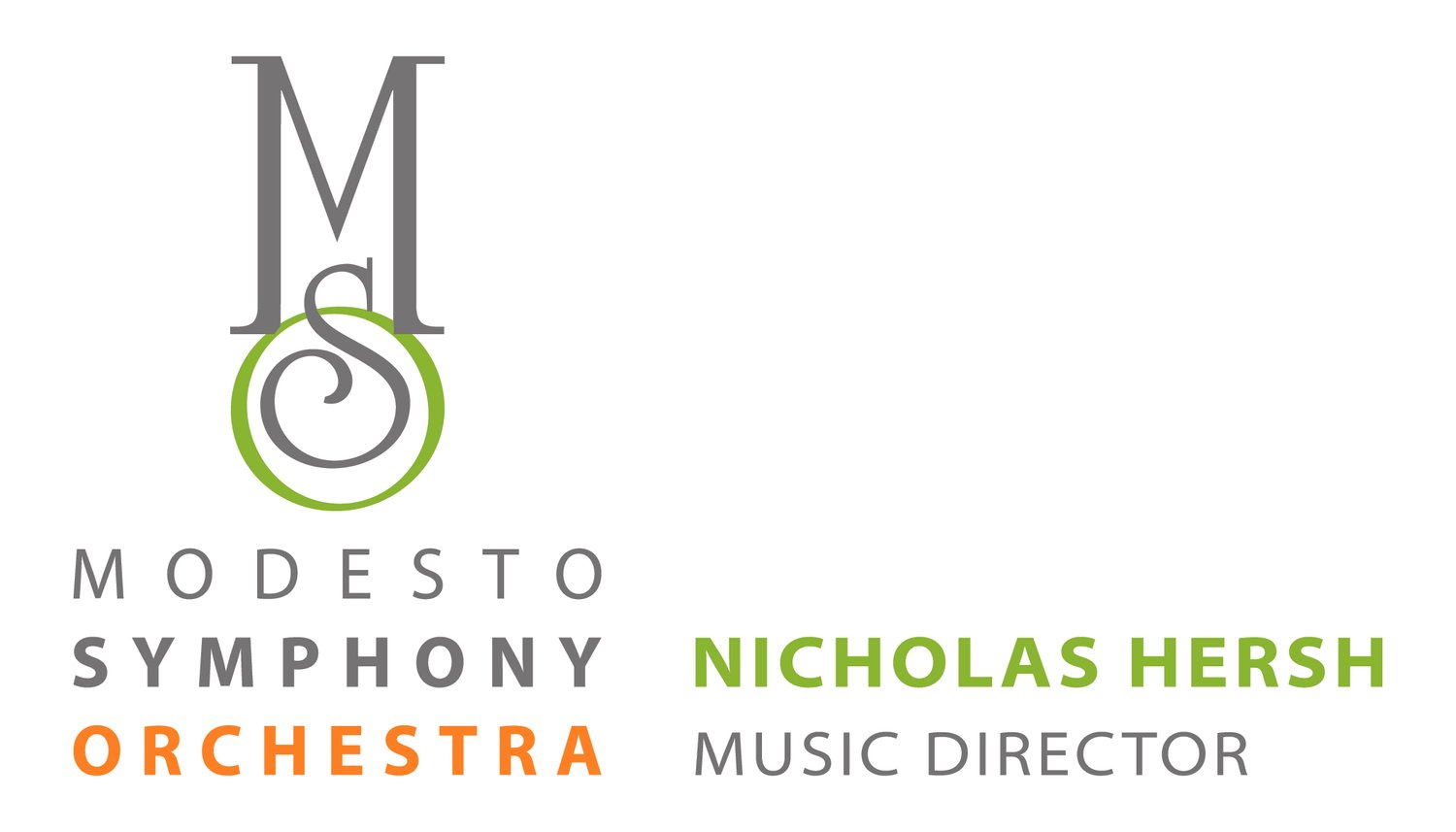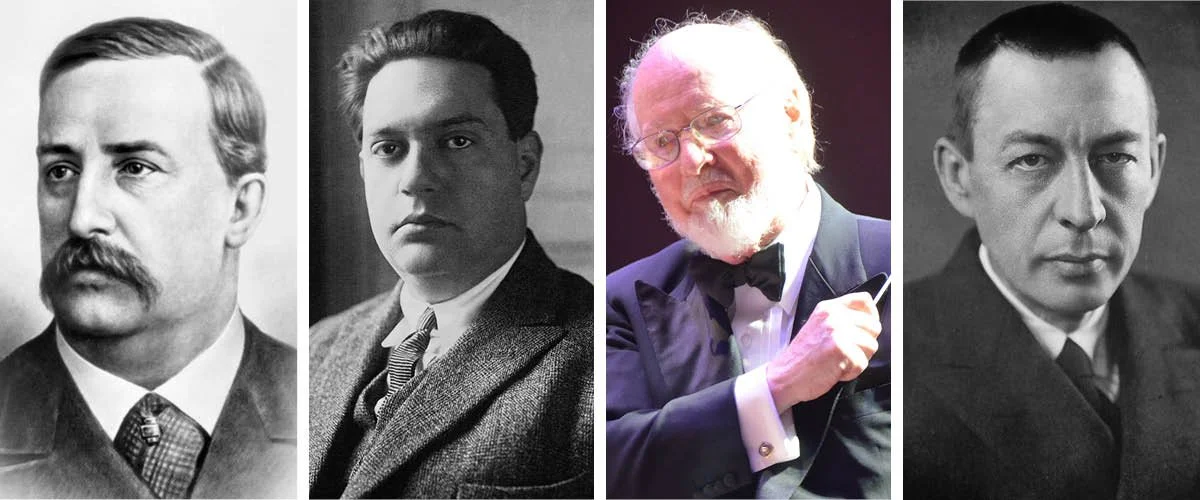Program Notes for october 5th, 2024
Branford Marsalis with the
Modesto Symphony Orchestra
Alexander Borodin
“Polovtsian Dances” from Prince Igor
Composer: born November 12, 1833, St. Petersburg; died February 27, 1887, St. Petersburg
Work composed: Borodin worked on Prince Igor from 1869-1874 and intermittently thereafter, but it remained uncompleted at the time of his death. Borodin’s friend and colleague, Nikolai Rimsky-Korsakov, orchestrated the Polovtsian Dances.
World premiere: Eduard Nápravnik led the first performance of Prince Igor on November 16, 1890, at the Mariinsky Theatre in St. Petersburg
Instrumentation: piccolo, 2 flutes, 2 oboes (1 doubling English horn), 2 clarinets, 2 bassoons, 4 horns, 2 trumpets, 3 trombones, tuba, timpani, bass drum, cymbals, glockenspiel, snare drum, suspended cymbal, tambourine, triangle, harp, and strings
Estimated duration: 14 minutes
Alexander Borodin, like the other members of the Kucha, or Mighty Five, wrote music in his spare time. (A music critic coined the nickname “The Kucha” in reference to a group of influential 19th century Russian composers based in St. Petersburg. In addition to Borodin, the group included Mily Balakirev, César Cui, Modest Mussorgsky, and Nikolai Rimsky-Korsakov). A chemist by profession, Borodin made significant contributions to both his profession and his avocation.
The Kucha aspired to create authentically Russian music, free from the domination of German aesthetics. To this end, the Kucha featured indigenous folk songs and dances from different regions of the Russian empire.
Borodin employed folk dance tunes most effectively in his unfinished opera Prince Igor, the tale of 12th-century prince Igor Sviatoslavich’s failed attempt to stop the invasion of the Polovtsian Tatars in 1185. In the opera’s second act, Igor and his son are captured and held in the Polovtsian military camp. To pass the time, the Polovtsians sing and dance for the captive Russians.
The opera Prince Igor has had a fitful performance history, but the ballet sequence known as the “Polovtsian Dances” quickly became a stand-alone orchestral piece, and Borodin’s most popular and most performed music.
In 1953, the Tony award-winning musical Kismet debuted on Broadway; two years later, MGM adapted it for film. Much of the music from Kismet was derived from Borodin’s music, including the “Polovtsian Dances,” and both musical and film versions introduced Borodin to new audiences. One of Borodin’s most unforgettable melodies became Kismet’s signature hit song, “Stranger in Paradise.”
Darius Milhaud
Scaramouche, Op. 165
Composer: born September 4, 1892, Marseilles; died June 22, 1974, Geneva
Work composed: 1935-37. Originally written for two pianos. Milhaud subsequently arranged Scaramouche for alto saxophone and orchestra. At Benny Goodman’s request, Milhaud also produced a version for clarinet and orchestra.
World premiere: 1937, at the Paris International Exposition.
Instrumentation: solo alto saxophone, 2 flutes (1 doubling piccolo), 2 oboes, 2 clarinets, 2 bassoons, 2 horns, 2 trumpets, 2 trombones, bass drum, castanets, cymbals, snare drum, and strings
Estimated duration: 11 minutes
In 1937, French pianist Marguerite Long asked her friend and colleague Darius Milhaud to compose a two-piano duet for her students to perform at the Paris International Exposition. Milhaud complied, repurposing some music he had written for a production of Moliere’s play Le médecin volant (The Flying Doctor) for the first and third movements. The central slow section of Scaramouche is another recycled work, an overture Milhaud wrote in 1936 for a French play based on the life of Simón Bolívar. (Milhaud, fascinated by the life of the man South Americans nicknamed “El Libertador,” also made Bolívar the subject of his third opera. However, none of the music Milhaud wrote for the play, including the excerpt that became the second movement of Scaramouche, ended up in the opera).
Scaramouche, one of the central characters from Renaissance Italy’s Commedia dell’arte, is most often portrayed as clown who specializes in pranks. Although the music for Milhaud’s Scaramouche derives from previously composed works, the ebullience and merriment of Scaramouche’s character permeates the music, particularly the final movement, in which infectious Brazilian samba rhythms support a delightfully cheeky melody.
Composers are not always the best judges of their own work. Camille Saint-Saëns refused to allow Carnival of the Animals to be published during his lifetime, because he didn’t want his reputation as a serious composer tarnished by what he considered a musical trifle. Today, of course, Carnival of the Animals is Saint-Saëns’ most performed and best-known works, and it has been delighting audiences for more than 100 years. Similarly, Milhaud thought little of Scaramouche, and urged his publisher to ignore it. Fortunately, the publisher did not listen to his client, and Scaramouche became immensely popular. Today it is one of the most-performed piano duets in the repertoire, and its many arrangements for soloist and orchestra attest to its enduring charm.
John Williams
“Escapades” from Catch Me If You Can
Composer: born February 8, 1932, Flushing, Queens
Work composed: 2002
World premiere: The film Catch Me If You Can with Williams’ score premiered on December 25, 2002
Instrumentation: 3 flutes, 2 oboes, 3 clarinets, bass clarinet, alto saxophone, tenor saxophone, 2 bassoons, 4 horns, 3 trumpets, 2 trombones, bass trombone, tuba, timpani, percussion, piano/celeste, harp, and strings
Estimated duration: 13 minutes
John Williams is synonymous with movie music. He became a household name with the Academy Award-winning score he wrote in 1977 for Star Wars, and he has defined the symphonic Hollywood sound ever since.
Over his career, Williams has garnered a record 54 Oscar nominations for Best Original Score, including the one he wrote for longtime collaborator Steven Spielberg’s 2002 film, Catch Me If You Can. The movie is based on Frank Abagnale’s eponymous autobiography, which details his criminal activities during the 1960s, as well as the FBI’s years-long campaign to apprehend him. Over seven years, Abagnale impersonated an airline pilot, a doctor, and a public prosecutor in the course of his successful efforts as a master conman and forger.
“The film is set in the now nostalgically tinged 1960s,” Williams writes about his music, “and so it seemed to me that I might evoke the atmosphere of that time by writing a sort of impressionistic memoir of the progressive jazz movement that was then so popular. The alto saxophone seemed the ideal vehicle for this expression ... “In ‘Closing In,’ we have music that relates to the often-humorous sleuthing which took place in the story, followed by ‘Reflections,’ which refers to the fragile relationships in Abnagale’s family. Finally, in ‘Joy Ride,’ we have the music that accompanies Frank’s wild flights of fantasy that took him all over the world before the law finally reined him in.”
Sergei Rachmaninoff
Symphonic Dances for Large Orchestra, Op. 45
Composer: born April 1, 1873, Oneg, Russia; died March 28, 1943, Beverly Hills, CA
Work composed: the summer and autumn of 1940. The published score bears the inscription: “Dedicated to Eugene Ormandy and The Philadelphia Orchestra.”
World premiere: Eugene Ormandy led the Philadelphia Orchestra on January 3, 1941
Instrumentation: piccolo, 2 flutes, 2 oboes, English horn, 2 clarinets, bass clarinet, alto saxophone, 2 bassoons, contrabassoon, 4 horns, 3 trumpets, 3 trombones, tuba, timpani, bass drum, chimes, cymbals, drum, orchestra bells, tam-tam, tambourine, triangle, xylophone, piano, harp, and strings
Estimated duration: 35 minutes
Sergei Rachmaninoff had great regard for the Philadelphia Orchestra and its music director, Eugene Ormandy. As a pianist, he had performed with them on several occasions, and as a composer, he appreciated the full rich sound Ormandy and his musicians produced. Sometime during the 1930s, Rachmaninoff remarked that he always had the unique sound of this ensemble in his head while he was composing orchestral music: “[I would] rather perform with the Philadelphia Orchestra than any other of the world.” When Rachmaninoff began working on the Symphonic Dances, he wrote with Ormandy and the orchestra in mind. Several of Rachmaninoff’s other orchestral works, including the Rhapsody on a Theme of Paganini and the Piano Concerto No. 4, were also either written for or first performed by Ormandy and the Philadelphia Orchestra.
The Symphonic Dances turned out to be Rachmaninoff’s final composition. Although not as well-known as the piano concertos or the Rhapsody on a Theme of Paganini, Rachmaninoff himself and many others regard the Symphonic Dances as his greatest orchestral work. “I don’t know how it happened,” the composer remarked. “It must have been my last spark.”
Nervous pulsing violins open the Allegro, over which the winds mutter a descending minor triad (three-note chord). The strings set a quickstep tempo, while the opening triad becomes both the melodic and harmonic foundation of the movement as it is repeated, reversed and otherwise developed. The introspective middle section features the first substantial melody, sounded by a distinctively melancholy alto saxophone. The Allegro concludes with a return of the agitated quickstep and fluttering triad.
Muted trumpets and pizzicato strings open the Andante con moto with a lopsided stuttering waltz, followed by a subdued violin solo. This main theme has none of the Viennese lightness of a Strauss waltz; its haunting, ghostly quality borders on the macabre suggestive of Sibelius’ Valse triste or Ravel’s eerie La valse. Rachmaninoff’s waltz is periodically interrupted by sinister blasts from the brasses.
In the Lento assai: Allegro vivace, Rachmaninoff borrows the melody of the Dies irae (Day of Wrath) from the requiem mass. Rachmaninoff had used this iconic melody many times before, most notably in Isle of the Dead and the Rhapsody on a Theme of Paganini. In the Symphonic Dances, the distinctive descending line has even more suggestive power; we can hear it as Rachmaninoff’s final statement about the end of his compositional career. This movement is the most sweeping and symphonic of the three and employs all the orchestra’s sounds, moods, and colors. In addition to the Dies irae, Rachmaninoff also incorporates other melodies from the Russian Orthodox liturgy, including the song “Blagosloven Yesi, Gospodi,” describing Christ’s resurrection, from Rachmaninoff's choral masterpiece, All-Night Vigil.
On the final page of the Symphonic Dances manuscript, Rachmaninoff wrote, “I thank Thee, Lord!”
© Elizabeth Schwartz
NOTE: These program notes are published here by the Modesto Symphony Orchestra for its patrons and other interested readers. Any other use is forbidden without specific permission from the author, who may be contacted at www.classicalmusicprogramnotes.com




















